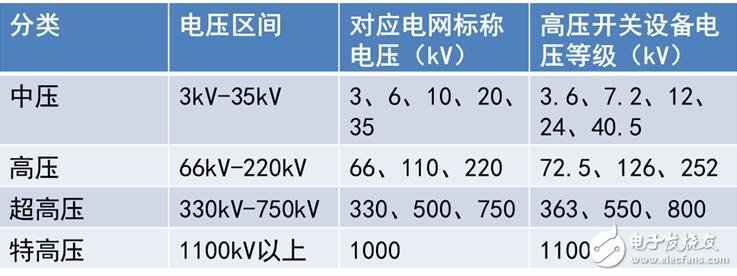The electricity used by the local government is 220V, and the industrial electricity is 380V. Why is the electricity coming out of the substation different from the user terminal? What is the difference between high pressure and low pressure?
Industrial electricity and residential electricity
Industrial electricity is actually the three-phase alternating current that we often refer to (the power system consisting of three AC circuits with the same frequency, equal potential amplitude and 120° phase difference), while the residential power supply uses a single-phase 220V pair. Residents supply electricity.
The three-phase alternating current can rotate the motor. When the three-phase alternating current flows into the three-phase stator winding, a rotating magnetic field is generated in the stator cavity. The rotor conductor that is stationary before the rotation is equivalent to the magnetic field line of the rotor conductor that relatively cuts the magnetic field under the action of the rotating magnetic field, thereby generating an induced current (electromagnetic induction principle) in the rotor conductor. These rotor conductors with induced currents move in the magnetic field, so industrial power is three-phase alternating current.

The voltage between the live and neutral lines of civil power is 220V, and the industrial power is the voltage between each phase line of 380V, and the voltage between phase and ground is 220V. Civil power is actually one of the three phases. The power plant to the residential substation is a 3-phase and 5-line. One of the functions of the substation is to divide the electricity into a number of 1-phase and 3-line lines for residents to use.
High pressure and low pressure boundary
According to the definition of 2.1 in GB/T 2900.50-2008, high [electrical] pressure generally refers to a voltage level higher than 1000V (not included), and low [electrical] pressure refers to a voltage of 1000V or less in an AC power system used for power distribution. Grade; internationally recognized high-voltage and low-voltage electrical appliances have a dividing line AC voltage of 1000V (DC is 1500V).
There is another saying in the industry that the voltage of 380V or above is called high-voltage electricity, so we are used to saying that 220V, 380V are low voltage, higher than this voltage is high voltage; before the electric industry regulations The prescribed boundary line is 250V. Although the new "Electricity Safety Work Regulations" has been introduced, many places have implemented the previous standards.

Popular classification of high voltage electrical appliances
1. There is no essential difference between the so-called high pressure, ultra high pressure and extra high pressure. (As the voltage increases, the insulation requirements and safety requirements will be different), but people's names are different. The dividing line is also customary and there is no clear regulation.
2. The power grid refers to the entire power supply and distribution system, including power plants, substations, lines, and power consumers.
3. For the purpose of protecting the normal operation of the equipment, the nominal voltage of the power grid is lower than the rated low voltage on the equipment, that is to say, the 12KV power equipment (or switch) is to be used for the 10KV power grid, and the 40.5KV power equipment. (or switch) to be used in the 35KV grid.
The voltage levels of substations that are common in China are generally divided into: 500KV and 750KV at the national level, 220KV at the provincial level, and 110KV, 66KV, 35KV, 10KV, and 400V at the prefecture level. At the same time, in order to better improve the quality of high-quality power, the state requires that nationwide substations need to install power quality online monitoring devices to monitor each bus. ZLG Zhiyuan Electronics' E8000 series power quality online monitoring device has a measuring accuracy of 0.1%, meets national standards and requirements, and meets all domestic voltage level grid measurement. It has become an indispensable professional monitoring device in the industry.
FUNCTION DESCRIPTION
Countdown socket has an AC outlet, the maximum can output 230 V16A of power, there are two control modes, that is, countdown off and countdown on. It is convenient to control the equipment which needs to switch off or turn on AC. improve the safety of the use of some equipment and save more energy.
SET Timer
1,Countdown plug in the socket, all indicator lights red flash three times, at this time the socket has no output, for the normal state, into the countdown state. Click the button, the first red light up, the socket output after an hour off, and then short press the button can set the socket timing of 2 H.4H.6H.8H.10H.OFF.
2,Long press button 3s, all indicator lights green flash three times, at this time the socket has output, for the regular open state, into the countdown on state. Click on the button, the first green light on, the socket is closed an hour later, and then press the button to set the socket countdown 2 H.4H.6H.8H.10H.OFF.
3,Press button 3 longer S, all indicator lights red light flash 3 times again into countdown mode.
4,Select the required countdown time mode, the corresponding mode countdown lights up, start countdown until the end of the countdown time. The outlet that controls the output will start or stop the output.
5,After the countdown starts, the time indicator will change automatically from high to low until the countdown is over.
NOTE:
1,Check that the power connection is good.
2,Use only indoors and in dry places.
3,This product does not convert AC voltage.
4,Maximum load not exceeding 16A 3680W.
5,Grounding is required for safety.
6,Any questions, please contact the electrician.
countdown timer socket, countdown timer plug, Countdown digital timer, Countdown socket, countdown switch socket
NINGBO COWELL ELECTRONICS & TECHNOLOGY CO., LTD , https://www.cowellsocket.com